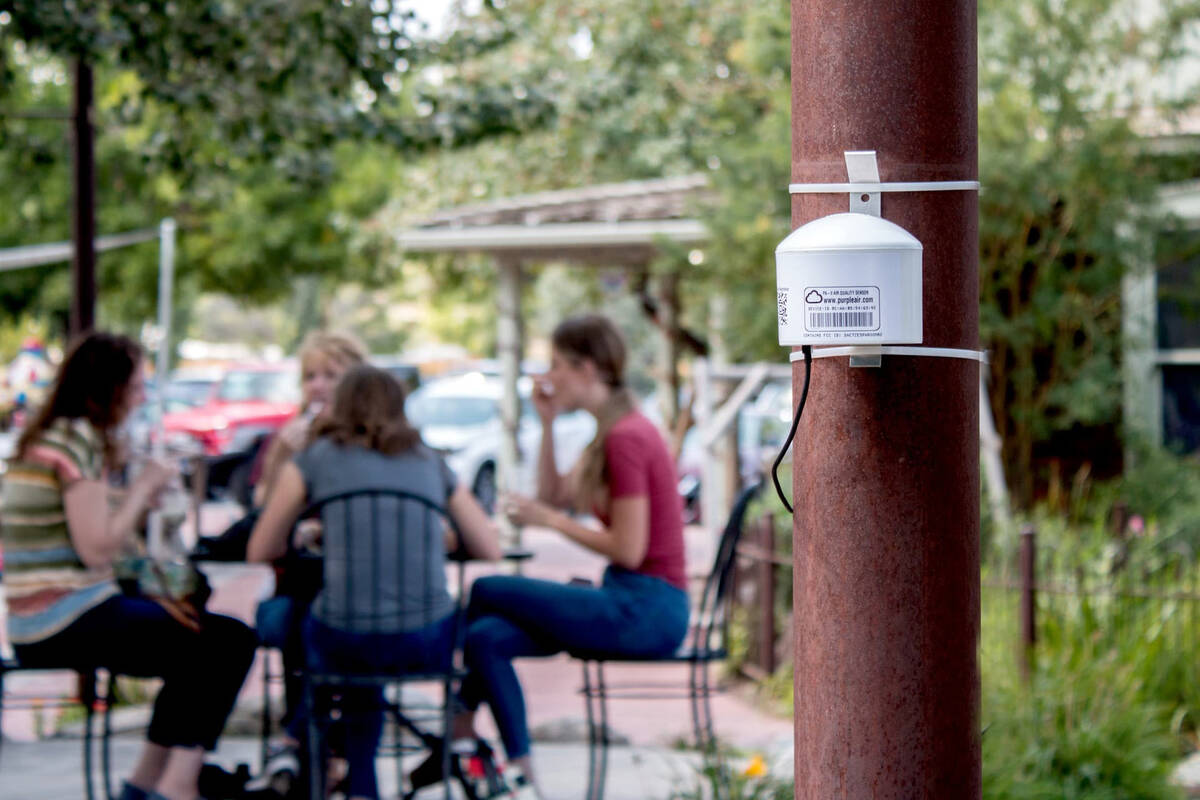This Vegas neighborhood is known for poor air quality. New sensors may help.

East Las Vegas is known, anecdotally, as having some of the poorest air quality in the city.
But a new project, known as Buen Aire Para Todos (“Good Air For All”), is hoping to beef up air quality monitoring efforts in the neighborhood to improve the well-being of its residents.
The project will install about 40 air quality monitors around various locations in east Las Vegas to track temperature and pollution from particulate matter.
Twenty of those air quality monitors will be at indoor residences throughout the area to monitor pollution inside buildings. Ten will be outdoors at parks, near roads, in parking lots and around green spaces. And 10 will be mobile, located on food trucks and street vendor carts to track the pollution that outdoor workers face as they go about their day.
Lauren Boitel, director of the sustainability nonprofit ImpactNV, said the community’s close proximity to the Spaghetti Bowl and other major transportation routes makes it vulnerable to air pollution because automobile emissions are a primary source of pollutants.
“(We wanted) to have the true data behind what we anecdotally know is a bad situation, environmentally and health-wise,” she said.
East Las Vegas is also home to a large Hispanic population, which comprises about 66 percent of residents.
“This research is going to be centered around real community,” said Audrey Peral, director of organizing at Make the Road Nevada, a community-based social justice organization in east Las Vegas. She’s hopeful that results from the project will allow Make the Road “to push for pieces of legislation that are going to help improve the quality of life of our families.”
The project, made possible by a grant from the EPA, is a collaboration between ImpactNV, Make the Road Nevada, the Desert Research Institute, the City of Las Vegas and the Las Vegas-Clark County Library District.
Monitoring, community outreach
The project plans to use PurpleAir monitors — each is about the size of a coffee cup and records real-time air quality data on a map that anyone can access.
And although anyone can buy a PurpleAir monitor, currently there’s a “vacuum” of space without any monitors over the east Las Vegas area.
“I don’t think that it’s because our communities wouldn’t want to participate,” Peral said. “I think it’s more so that we haven’t made things like this accessible.”
Perhaps proving Peral’s point, Derek Kauneckis, associate research professor at the Desert Research Institute, said that the team has already gotten interest from residents and business owners about receiving a monitor for the study. He expects that they’ll ultimately get many more requests than they’ll be able to accommodate.
“I really want as many folks as possible to participate,” said Peral. “I know that we don’t have enough space for everyone, but it’s going to be a great opportunity for some folks to be part of the research project.”
Participants will receive a small stipend to provide compensation for their time and to offset the small electrical costs associated with keeping the sensors plugged in. Residential participants will receive new air filters each month for a year.
Community engagement is a critical component of the project. “It’s really about bringing the data to where people interact,” Kauneckis said. “Not just collecting it and posting it and expecting people to come but really engaging the community both in the collection of the data, and then co-development of how we’re going to use it.”
To this end, the East Las Vegas Library will serve as an important community gathering place for people to learn about and discuss the air quality monitoring project.
Matt McNally, community engagement director for the Las Vegas-Clark County Library District, said that the library will be planning informational events and potentially developing youth programs to teach people about the importance of air quality monitoring and citizen science.
“We’re excited to see some of the real-time data and to share some of that data with the community,” he said.
‘Our Future East Las Vegas’
On a broader scale, Marco Velotta, planning project manager with the City of Las Vegas, said that the air quality data collected from the project will be useful to city officials as they finalize and implement a neighborhood revitalization plan for east Las Vegas called Nuestro Futuro Este de Las Vegas (“Our Future East Las Vegas”).
In addition to air quality, the plan addresses other problems affecting east Las Vegas, such as the urban heat island effect, the aging housing stock and the overall lack of quality affordable housing.
“I don’t like to throw the term environmental justice around,” Velotta said. “But that’s fundamentally what it is. We want to make sure that people are living in an environment that is better off than before.”
The City of Las Vegas will keep a close eye on how air quality changes as it begins to implement its revitalization plan for east Las Vegas so decisions can be made about how to proceed. Velotta added that the hope is for air quality to get better.
“This is really a process about giving people information they can use and putting it in a format that makes the most sense for decision-makers all up and down the chain,” Kauneckis at the Desert Research Institute said. “I mean from individual households to counties and local governments and states.”
Colton Poore is a 2022 Mass Media reporting fellow through the American Association for the Advancement of Science. Email him at cpoore@reviewjournal.com or follow him on Twitter @coltonlpoore.